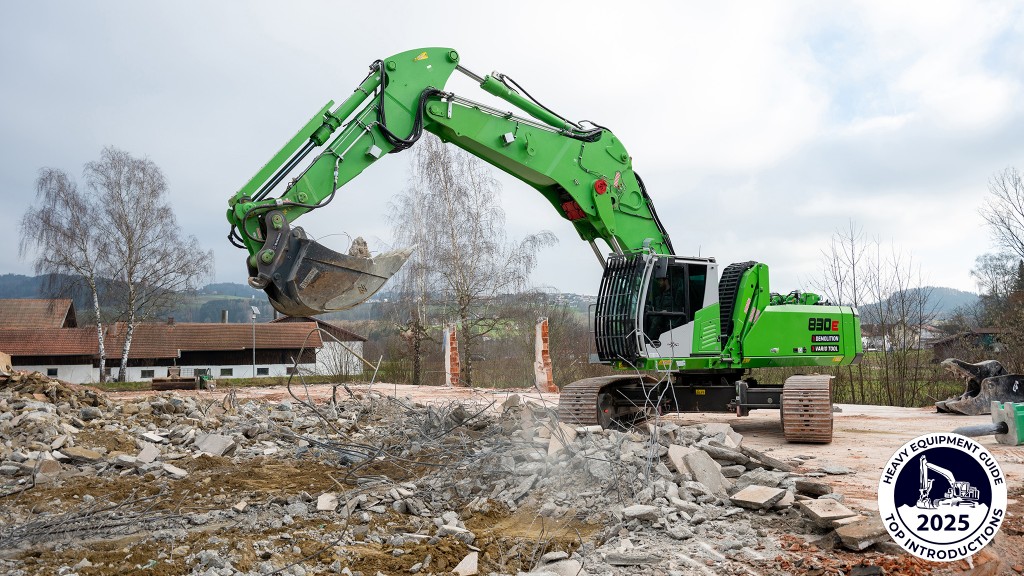
An Indeco ISS 45/90 is cutting up the steel structure of the old Kosciuszko Bridge in one of the most important demolition jobs taking place in New York City.
Opened in 1939, the Kosciuszko Bridge crossing Newtown Creek to link Green Point, Brooklyn with Maspeth, Queens has been out of service since last April and is now undergoing demolition. Despite that it had been rehabilitated in 1973, and again in 1996-97, the structure was constantly being monitored since the early 2000s.
Following a decision to replace the 1,835 meter-long bridge, in 2009 the New York State Dept. of Transportation (NYS-DOT) launched a plan for the construction of two new cable-stayed bridges, while maintaining the original name of the bridge, to effectively improve traffic flow.
The contract for the construction of the first new bridge was awarded to a joint venture made up of Skanska, Kiewit and ECCO III Enterprises, which finished building the first bridge last April. The JV was also assigned demolition of the entire old bridge, started last July 24th when the main span (91.5 meters in length, 27 meters in width, 15.2 meters in height and a weight of almost 2,268 metric tons) crossing Newtown Creek was first sectioned and then, after being lowered 38 meters via a strand jacking system, set onto two barges for transport to a recycling facility where it would be demolished.
The problem remained of how to demolish the approaches, which were the most extensive part of the whole bridge (totalling over 1.700 meters), consisting of 21 spans ranging from 36 meters to 70 meters resting on reinforced concrete piers for a total of 31,500 metric tons of steel and 68,000 cubic meters of reinforced concrete.
After an in-depth analysis of the original bridge framing plan, it was decided that the most efficient way to demolish the old structure was to perform cuts in key points, then use explosives to "set it down" -- in a single blast to collapse all 21 spans -- onto a bed of dirt that would soften the impact. Once down, the structure would be mechanically demolished (shears for the steel structures, hydraulic hammers for the piers in reinforced concrete).
The JV subcontracted the demolition of the Kosciuszko Bridge to Breeze, one the major contractors in the New York City area specializing in demolition. Among Breeze's other big projects was the dismantling of the old Shea Stadium and demolition of the Hotel Dorset to make room for an addition to the Museum of Modern Art. Considering the size of the structure and the timeframe to complete the job (by year end), Breeze decided to make minimal use of flame-cutting, opting instead for shears mounted on an excavator. For this reason, the contractor purchased a brand new ISS 45/90 from Indeco to add to their fleet of demolition equipment.
Demolition started with the first span on the Queens side, which was entirely demolished using shears, i.e., not collapsed to the ground using explosives, since the only access to the last exit to Brooklyn could not be blocked and because explosives would have induced stress to the successive spans, which had already been prepped with cuts and sectioning for later blasting.
The number of structural members of the bridge and their size called for powerful, hard-wearing shears. The web of some of the I-beams had a thickness of over 5 cm, while the upper chords measured 34 cm in height, 54 cm in width and were built with steel elements 32, 19, 16 and 13 mm in thickness.
Breeze, who is a long-time user of Indeco equipment (the company owns 22 hammers, 2 shears and 2 multi-grabs), decided to buy an ISS 45/90 from Indeco dealer Alessi Equipment. The choice was not solely based on brand loyalty: the shears were the best in their weight class (9700 kg) in terms of clamping force (2500 metric tons), maximum force at the tip (275 metric tons) and maximum jaw opening (1100 mm).
The ISS 45/90 is made entirely of special extra-strength Hardox, and thanks to a cylinder that can manage pressures up to 700 bar, the attachment has the structural strength and the power to take on any type of job. The shears also feature a dual guide that keeps the jaws perfectly aligned and prevents buckling. The dual regeneration valve speeds up the movement of the jaw (accelerating opening and closing, thus improving productivity), while the V-Ripper RazorDual piercing design of both the upper and lower jaws improves cutting performance.
Like all other Indeco shears, the ISS 45/90 also boasts a very favorable weight-to-power ratio that improves the efficiency of the attachment. Breeze coupled the shears to a Komatsu PC 800 via an original Indeco special mounting bracket specifically adapted to fit the boom carrier. At times, the cutting process proved challenging due to the size of the structures. As known, when I-beams are cut, the shears first bend the web and flanges, doubling (and sometimes tripling) the thickness that is to be cut. Despite the sizes of the various members and the enormous amount of steel to be sectioned, the ISS 45/90 delivered top-notch performance.



